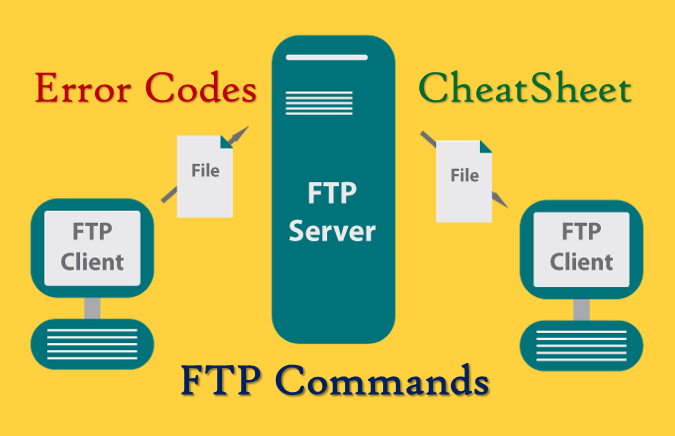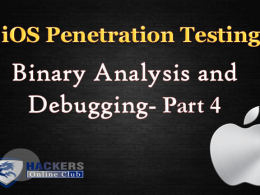FTP- The File Transfer Protocol is a standard network protocol used for the transfer of computer files between a client and server on a computer network.
FTP is built on a client-server model architecture using separate control and data connections between the client and the server.
In this article you will find FTP Server Commands And Error Codes List
FTP server return codes always have three digits, and each digit has a special meaning.
1xx – Positive Preliminary reply
The requested action is being initiated, expect another reply before proceeding with a new command. (The user-process sending another command before the completion reply would be in violation of protocol, but server-FTP processes should queue any commands that arrive while a preceding command is in progress).
This type of reply can be used to indicate that the command was accepted and the user-process may now pay attention to the data connections, for implementations where simultaneous monitoring is difficult. The server-FTP process may send at most, one 1xx reply per command.
2xx – Positive Completion reply
The requested action has been successfully completed. A new request may be initiated.
3xx – Positive Intermediate reply
The command has been accepted, but the requested action is being held in abeyance, pending receipt of further information. The user should send another command specifying this information. This reply is used in command sequence groups.
4xx – Transient Negative Completion reply
The command was not accepted and the requested action did not take place, but the error condition is temporary and the action may be requested again. The user should return to the beginning of the command sequence, if any.
It is difficult to assign a meaning to “transient”, particularly when two distinct sites (Server- and User-processes) have to agree on the interpretation. Each reply in the 4xx category might have a slightly different time value, but the intent is that the user-process is encouraged to try again.
A rule of thumb in determining if a reply fits into the 4xx or the 5xx (Permanent Negative) category is that replies are 4xx if the commands can be repeated without any change in command form or in properties of the User or Server (e.g., the command is spelled the same with the same arguments used; the user does not change his file access or user name; the server does not put up a new implementation.)
5xx – Permanent Negative Completion reply
The command was not accepted and the requested action did not take place. The User-process is discouraged from repeating the exact request (in the same sequence). Even some “permanent” error conditions can be corrected, so the human user may want to direct his User-process to reinitiate the command sequence by direct action at some point in the future (e.g., after the spelling has been changed, or the user has altered his directory status.)
6xx – Protected reply
The RFC 2228 introduced the concept of protected replies to increase security over the FTP communications. The 6xx replies are Base64 encoded protected messages that serves as responses to secure commands. When properly decoded, these replies fall into the above categories.
Also Read- Learn TCP/IP And Routers
The second digit is a grouping digit and encodes the following information:
Range Purpose
- x0x Syntax
These replies refer to syntax errors, syntactically correct commands that don’t fit any functional category, unimplemented or superfluous commands. - x1x Information
These are replies to requests for information, such as status or help. - x2x Connections
Replies referring to the control and data connections. - x3x Authentication and accounting
Replies for the login process and accounting procedures. - x4x Unspecified as of RFC 959.
- x5x File system
These replies indicate the status of the Server file system vis-a-vis the requested transfer or other file system action.
Below is a list of all known return codes that may be issued by an FTP server.
- 100 Series The requested action is being initiated, expect another reply before proceeding with a new command
- 110 Restart marker reply. In this case, the text is exact and not left to the particular implementation; it must read: MARK yyyy = mmmm where yyyy is User-process data stream marker, and mmmm server’s equivalent marker (note the spaces between markers and “=”).
- 120 Service ready in nnn minutes.
- 125 Data connection already open; transfer starting.
- 150 File status okay; about to open data connection.
- 200 Command okay.
- 202 Command not implemented, superfluous at this site.
- 211 System status, or system help reply.
- 212 Directory status.
- 213 File status.
- 214 Help message.On how to use the server or the meaning of a particular non-standard command. This reply is useful only to the human user.
- 215 NAME system type. Where NAME is an official system name from the list in the Assigned Numbers document.
- 220 Service ready for new user.
- 221 Service closing control connection.
- 225 Data connection open; no transfer in progress.
- 226 Closing data connection. Requested file action successful (for example, file transfer or file abort).
- 227 Entering Passive Mode (h1,h2,h3,h4,p1,p2).
- 230 User logged in, proceed. Logged out if appropriate.
- 250 Requested file action okay, completed.
- 257 “PATHNAME” created.
- 331 User name okay, need password.
- 332 Need account for login.
- 350 Requested file action pending further information
- 421 Service not available, closing control connection.This may be a reply to any command if the service knows it must shut down.
- 425 Can’t open data connection.
- 426 Connection closed; transfer aborted.
- 450 Requested file action not taken.
- 451 Requested action aborted. Local error in processing.
- 452 Requested action not taken. Insufficient storage space in system.File unavailable (e.g., file busy).
- 500 Syntax error, command unrecognized. This may include errors such as command line too long.
- 501 Syntax error in parameters or arguments.
- 502 Command not implemented.
- 503 Bad sequence of commands.
- 504 Command not implemented for that parameter.
- 530 Not logged in.
- 532 Need account for storing files.
- 550 Requested action not taken. File unavailable (e.g., file not found, no access).
- 551 Requested action aborted. Page type unknown.
- 552 Requested file action aborted. Exceeded storage allocation (for current directory or dataset).
- 553 Requested action not taken. File name not allowed.
- 600 Series Replies regarding confidentiality and integrity
- 631 Integrity protected reply.
- 632 Confidentiality and integrity protected reply.
- 633 Confidentiality protected reply.
- 10000 Series Common Winsock Error Codes (These are not FTP return codes)
- 10054 Connection reset by peer. The connection was forcibly closed by the remote host.
- 10060 Cannot connect to remote server.
- 10061 Cannot connect to remote server. The connection is actively refused by the server.
- 10066 Directory not empty.
- 10068 Too many users, server is full.
Important FTP Commands Cheat sheet
A list of FTP commands that may be sent to an FTP server, including all commands that are standardized in RFC 959 by the IETF (Internet Engineering Task Force).
RFC- Stands for Request for Comments
- Command RFC Description
- ABOR Abort an active file transfer.
- ACCT Account information.
- ADAT RFC 2228 Authentication/Security Data
- ALLO Allocate sufficient disk space to receive a file.
- APPE Append (with create)
- AUTH RFC 2228 Authentication/Security Mechanism
- AVBL Streamlined FTP Command Extensions Get the available space
- CCC RFC 2228 Clear Command Channel
- CDUP Change to Parent Directory.
- CONF RFC 2228 Confidentiality Protection Command
- CSID Streamlined FTP Command Extensions Client / Server Identification
- CWD RFC 697 Change working directory.
- DELE Delete file.
- DSIZ Streamlined FTP Command Extensions Get the directory size
- ENC RFC 2228 Privacy Protected Channel
- EPRT RFC 2428 Specifies an extended address and port to which the server should connect.
- EPSV RFC 2428 Enter extended passive mode.
- FEAT RFC 2389 Get the feature list implemented by the server.
- HELP Returns usage documentation on a command if specified, else a general help document is returned.
- HOST RFC 7151 Identify desired virtual host on server, by name.
- LANG RFC 2640 Language Negotiation
- LIST Returns information of a file or directory if specified, else information of the current working directory is returned.
- LPRT RFC 1639 Specifies a long address and port to which the server should connect.
- LPSV RFC 1639 Enter long passive mode.
- MDTM RFC 3659 Return the last-modified time of a specified file.
- MFCT The ‘MFMT’, ‘MFCT’, and ‘MFF’ Command Extensions for FTP Modify the creation time of a file.
- MFF The ‘MFMT’, ‘MFCT’, and ‘MFF’ Command Extensions for FTP Modify fact (the last modification time, creation time, UNIX group/owner/mode of a file).
- MFMT The ‘MFMT’, ‘MFCT’, and ‘MFF’ Command Extensions for FTP Modify the last modification time of a file.
- MIC RFC 2228 Integrity Protected Command
- MKD Make directory.
- MLSD RFC 3659 Lists the contents of a directory if a directory is named.
- MLST RFC 3659 Provides data about exactly the object named on its command line, and no others.
- MODE Sets the transfer mode (Stream, Block, or Compressed).
- NLST Returns a list of file names in a specified directory.
- NOOP No operation (dummy packet; used mostly on keepalives).
- OPTS RFC 2389 Select options for a feature (for example OPTS UTF8 ON).
- PASS Authentication password.
- PASV Enter passive mode.
- PBSZ RFC 2228 Protection Buffer Size
- PORT Specifies an address and port to which the server should connect.
- PROT RFC 2228 Data Channel Protection Level.
- PWD Print working directory. Returns the current directory of the host.
- QUIT Disconnect.
- REIN Re initializes the connection.
- REST RFC 3659 Restart transfer from the specified point.
- RETR Retrieve a copy of the file
- RMD Remove a directory.
- RMDA Streamlined FTP Command Extensions Remove a directory tree
- RNFR Rename from.
- RNTO Rename to.
- SITE Sends site specific commands to remote server (like SITE IDLE 60 or SITE UMASK 002). Inspect SITE
- HELP Output for complete list of supported commands.
- SIZE RFC 3659 Return the size of a file.
- SMNT Mount file structure.
- SPSV FTP Extension Allowing IP Forwarding (NATs) Use single port passive mode (only one TCP port number for both control connections and passive-mode data connections)
- STAT Returns the current status.
- STOR Accept the data and to store the data as a file at the server site
- STOU Store file uniquely.
- STRU Set file transfer structure.
- SYST Return system type.
- THMB Streamlined FTP Command Extensions Get a thumbnail of a remote image file
- TYPE Sets the transfer mode (ASCII/Binary).
- USER Authentication username.
- XCUP RFC 775 Change to the parent of the current working directory
- XMKD RFC 775 Make a directory
- XPWD RFC 775 Print the current working directory
- XRCP RFC 743
- XRMD RFC 775 Remove the directory
- XRSQ RFC 743
- XSEM RFC 737 Send, mail if cannot
- XSEN RFC 737 Send to terminal











